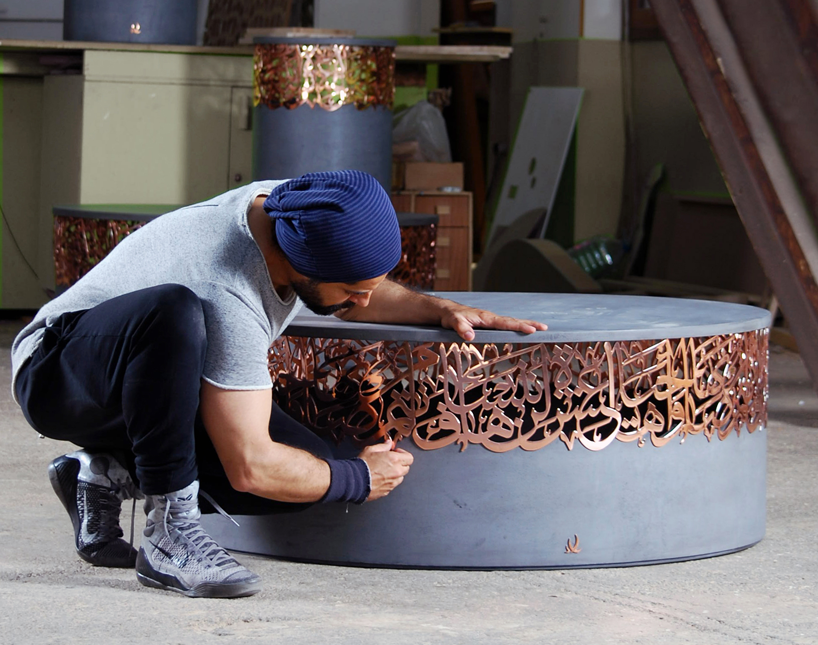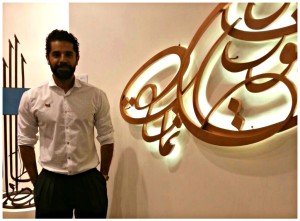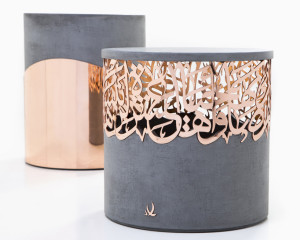
Arabic calligraphy is one of the most beautiful forms of calligraphy there is. Each letter curves in a way that makes you fascinated and feel awe in disbelief that letters can look so beautiful. Calligraphy is not just a form of art, but holds historical and cultural meanings that make it even prettier.
 Inspired by Arabic heritage and artistic detail, Iyad Naja brings his expressive concepts to many creative disciplines. He received his BS degree in Graphic Design from LAU Beirut in 2000. Naja worked in advertising and became a creative director at one of the international advertising agencies, but his love for Arabic calligraphy and product design took over.
Inspired by Arabic heritage and artistic detail, Iyad Naja brings his expressive concepts to many creative disciplines. He received his BS degree in Graphic Design from LAU Beirut in 2000. Naja worked in advertising and became a creative director at one of the international advertising agencies, but his love for Arabic calligraphy and product design took over.
Looking at the amount of beauty found in the heritage and culture of the Arab world, Naja realized his passion lies in design and more specifically in Arabic calligraphy and product design. Naja believes we need to celebrate and appreciate the beauty of our heritage and let it manifest in all forms of art, showing just how proud we are.
 Iyad Naja not only understands the fascination that Arabic calligraphy holds, but has integrated it into his artistic designs, interweaving traditional motifs with modern technologies in a series of magnificent stools. Using materials such as concrete and metal, which are typically used in architectural elements, Naja mixes the organic, flow of calligraphy with the weighted, heavy materials to represent quality.
Iyad Naja not only understands the fascination that Arabic calligraphy holds, but has integrated it into his artistic designs, interweaving traditional motifs with modern technologies in a series of magnificent stools. Using materials such as concrete and metal, which are typically used in architectural elements, Naja mixes the organic, flow of calligraphy with the weighted, heavy materials to represent quality.
For the first set of stools, Naja uses an artistic composition of calligraphy made of metal, and sculpts them into a circular form to circulate the concrete base. The spaces between the calligraphic forms are carved out, allowing the light to pass through and reveal the multiple layers and character of the forms.
 A simpler version of the stools was made in a second series, “kintsu-k”, where the sculpted metallic sheets of the composition of Arabic calligraphy are wrapped around the outer part of solid concrete, forming a strong contrast between the two materials that are very eye-catching.
A simpler version of the stools was made in a second series, “kintsu-k”, where the sculpted metallic sheets of the composition of Arabic calligraphy are wrapped around the outer part of solid concrete, forming a strong contrast between the two materials that are very eye-catching.
Merging the two materials together represents the contradictions we have in our culture and shows depth, with delicacy and solidity appearing in layers. Many artists have tried to use Arabic calligraphy in their artwork, inserting it in the wrong context, making the artwork feel old or disconnected. Naja, however, incorporates the calligraphy with a modern touch, choosing the font and design that matches the theme of the products being used.
WE SAID THIS: For more information on Iyad Naja’s artwork, you can like his Facebook page here.


